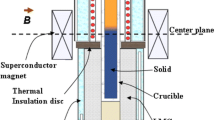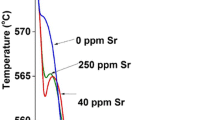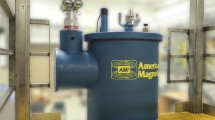Abstract
In order to investigate the effects of high magnetic fields on the as-solidified structures of Al alloys, solidification experiments of hypoeutectic and hypereutectic Al–Si alloys under various high magnetic field conditions (up to 12 T) have been conducted. It was found that uniform magnetic fields and gradient magnetic fields affect the solidification process by Lorentz force and magnetization force, respectively. The primary silicon crystals of hypereutectic Al–Si alloys are distributed, relatively, homogeneously under uniform magnetic fields, whereas they congregate near the top surface or bottom of samples by the combined action of buoyancy and magnetization force under gradient magnetic fields. The results indicate that it is possible to control the behaviors of reinforced particles in the metal matrix and improve the material performances by using high magnetic fields in the solidification process of metal matrix composites. The experiments also showed that high magnetic fields decrease the interlamellar spacing of the eutectic structure, while there exists a certain optimum value of magnetic intensity corresponding to the minimum value of interlamellar spacing, and magnetic energy is capable of influencing thermodynamic equilibrium of solidifying system and makes the content of eutectic aluminum in eutectic structures increased.





Similar content being viewed by others
References
Asai S (2003) In: Asai S, Fautrelle Y, Gillon P, Durand F (eds) Proceedings of the 4th International Conference on Electromagnetic Processing of Materials, Lyon, The Company Forum Edition, Lyon, p 1
Asai S (2000) Sci Technol Adv Mater 1:191
Jones TB (1979) J Appl Phys 50:5057
Garcia A, Moron C, Maganto F (2003) Sensor Actuat A-Phys 106:108
Negrini F, Fabbri M, Zuccarini M, Takeuchi E (2000) Energy Convers Manage 41:1687
Asai S (2004) Model Simul Mater Sci Eng 12:R1
Asai S, Sassa K, Tahashi M (2003) Sci Technol Adv Mater 4:455
Schneider-Muntau HJ, Brandt BL, Brunel LC, Cross TA, Edison AS, Marshall AG, Reyes AP (2004) Physica B 346–347:643
Perenboom JAAJ, Wiegers SAJ, Christianen PCM, Zeitler U, Maan JC (2004) Physica B 346–347:659
Kang JY, Tozawa S (1996) Acta Phys Sin 45:324
Wang Q, Wang CJ, Wang EG, He JC (2005) Acta Metall Sin (in Chinese) 41:128
Wang H, Ren ZM, Deng K, Xu KD (2002) Acta Metall Sin (in Chinese) 38:41
Morikawa H, Sassa K, Asai S (1998) Mater Trans JIM 39:814
Yasuda H, Ohnaka I, Ninomiya Y, Ishii R, Fujita S, Kishio K (2003) In: Asai S, Fautrelle Y, Gillon P, Durand F (eds) Proceedings of the 4th International Conference on Electromagnetic Processing of Materials, Lyon, The Company Forum Edition, Lyon, p 459
Nakada M, Mori K, Nishioka S, Tsutsimi H (1997) ISIJ Int 37:358
Yasuda H, Ohnaka I, Kawakami O, Ueno K, Kishio K (2003) ISIJ Int 43:942
Wang Q, Wang EG, He JC, Hu K, Takahashi K, Watanabe K (2003) In Asai S, Fautrelle Y, Gillon P, Durand F (eds) Proceedings of the 4th International Conference on Electromagnetic Processing of Materials, Lyon, The Company Forum Edition, Lyon, p 464
Wang Q, Wang CJ, Pang XJ, He JC (2004) Chinese J Mater Res (in Chinese) 18:568
Ikezoe Y, Kaihatsu T, Uetake H, Hirota N, Nakagawa J, Kitazana K (2000) Trans Mater Res Soc Jpn 25:77
Robert C (1982–1983) In: CRC Handbook of Chemistry and Physics (the 63rd edition), CRC Press, Inc., Florida, p B-244
The Japan Institute of Metals (1993) In: Data handbook of metals (the Third Edition, in Japanese), Maruzen Co. Ltd, Shizuoka, p 18
Acknowledgement
This work was supported by the National Natural Science Foundation of China (Grant No. 50374027), the Program for New Century Excellent Talents in University (Grant No. NCET-06-0289) and the 111 project (Grant No. B07015).
Author information
Authors and Affiliations
Corresponding author
Rights and permissions
About this article
Cite this article
Wang, Q., Wang, Cj., Liu, T. et al. Control of solidified structures in aluminum–silicon alloys by high magnetic fields. J Mater Sci 42, 10000–10006 (2007). https://doi.org/10.1007/s10853-007-2050-7
Received:
Accepted:
Published:
Issue Date:
DOI: https://doi.org/10.1007/s10853-007-2050-7




